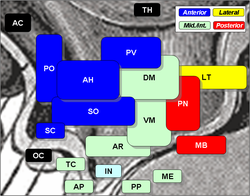Lateral hypothalamic area
| Lateral hypothalamus | |
|---|---|

Lateral hypothalamus is 'LT', at right, in yellow.
|
|
| Identifiers | |
| MeSH | A08.186.211.730.385.357.300 |
| NeuroNames | hier-409 |
| NeuroLex ID | Lateral hypothalamus |
| TA | A14.1.08.929 |
| FMA | 62030 |
|
Anatomical terms of neuroanatomy
[]
|
|
The lateral hypothalamus, also called the lateral hypothalamic area, contains the primary orexinergic nucleus within the hypothalamus that widely projects throughout the nervous system; this system of neurons mediates an array of cognitive and physical processes, such as promoting feeding behavior and arousal, reducing pain perception, and regulating body temperature, digestive functions, and blood pressure, among many others. Clinically significant disorders that involve dysfunctions of the orexinergic projection system include narcolepsy, motility disorders or functional gastrointestinal disorders involving visceral hypersensitivity (e.g., irritable bowel syndrome), and eating disorders.
The neurotransmitter glutamate and the endocannabinoids (e.g., anandamide) and the orexin neuropeptides orexin-A and orexin-B are the primary signaling neurochemicals in orexin neurons; pathway-specific neurochemicals include GABA, melanin-concentrating hormone, nociceptin, glucose, the dynorphin peptides, and the appetite-regulating peptide hormones leptin and ghrelin, among others. Notably, cannabinoid receptor 1 (CB1) is on orexinergic projection neurons in the lateral hypothalamus and many output structures, where the CB1 and orexin receptor 1 (OX1) receptors form the CB1–OX1 receptor heterodimer.
...
Wikipedia
